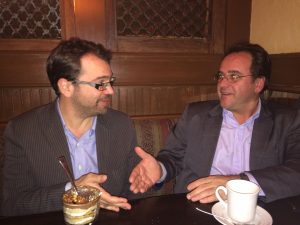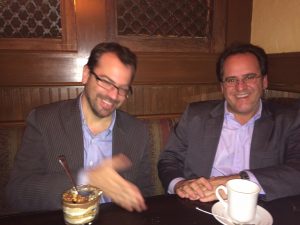Recently, Graham Kilshaw, President of ITEM Media and Interference Technology, had the privilege of having dinner with Benoit Derat, CEO of ART-Fi, and Mike Violette, CEO of American Certification Body (ACB). The group discussed interesting developments in SAR (Specific Absorption Rate) during their meeting, and for the benefit of our readers involved in wireless device design and development, here is a recap of the conversation:

Mike: Benoit, European SAR limits are slightly higher than here in the US, aren’t they? Is there a greater concern on SAR by handset targeting the US?
Benoit: I would say the concern is equal, however, the main differences are the limits and the measurements. In Europe (and in a majority of regions) the limit is 2W/kg, compared to the limit of 1.6W/kg in the US. The EU requirements are based on an averaging over 10 grams of tissue. In the US, the average volume is 1 gram. The reasons for this difference are long to explain but they are mainly historical and political. The US requirements are certainly more stringent. But if all nations were to adopt the 2 W/kg over 10g, the world would not be less safe for that. This limit is actually endorsed by WHO.
Mike: FCC approval process includes a review of wireless device SAR test report during certification. Is SAR compliance judged differently in Europe?
Benoit: Yes, it is different. In Europe, everything is based on the DoC (Declaration of Conformity). The evidence of conformity includes the test reports in a technical documentation which is drawn up by the manufacturer. This document is not shared with authorities in the first place and no process for issuing certification after review holds in the EU. However, national surveillance authorities have the legal right to obtain the technical documentation to verify conformity of the product. They would generally do that only if they have a presumption of non-compliance.
Mike: I think a lot of handset makers are very concerned about any possibility of bad PR about a phone or wireless device that has higher SAR measurements, even if they are well within the limits, so I think most are producing devices that are ultra conservative in their readings. Are you seeing that in Europe too?

Benoit: Manufacturers usually adopt the position supported by WHO: “research does not suggest any consistent evidence of adverse health effects from exposure to radiofrequency fields at levels below exposure limits.” This means that, from a SAR perspective, devices which comply with regulatory limits are equally good and SAR is not a field of competition. Manufacturers are not so much concerned with higher SAR if it is within the limits, but they are surely concerned with the risk of non-compliance. They are also concerned about publishing SAR values in their user manuals that strongly underestimate the actual SAR value of the device. So yes, they may be sometimes conservative and announce higher SAR values in their manuals in order to cover for potential mass production deviations. Or they voluntarily reduce the transmit power in specific modes.
Graham: So Mike what does that ultra conservative approach mean in the end for the consumer?
Mike: If you go back to the derivation of the limit, which began with the first studies in 1960, the maximum permissible exposure value was pegged to about 5% of the measurable rise in temperature of body tissue from the influence of electromagnetic radiation, so being more conservative doesn’t really change the safety question. If the handset makers are being too conservative, the device would have a lesser range from the cell base station, which affects performance. In a competitive environment, this is a critical issue.
Mike: Part of the challenge of course, is verifying conformance at the production level and sometimes accuracy is compromised and that’s where a conservative approach to tuning up the radios further affects performance.
Benoit: Yes, that’s for sure, some manufacturers certainly make a lot of the testing in production with simple setups like small shield room equipped with couplers enabling an approximate assessment of radiated power. They may then correlate the variations of radiated power with SAR to characterize which sort of SAR dipersion they can expect in their production batches. SAR measurements made with robot systems are done on a limited number of samples picked at defined timesteps from the production lines.

Mike: We (ACB) are seeing a lot more development and testing of mobile, wearable coming up for certification these days. Are you seeing that area growing in Europe also?
Benoit: Well I do not certify and do not sell test services. But for sure wearables and connected objects are a big trend. On our side, the SAR system manufacturer’s, we are having more and more discussions with our customers willing to test watches, glasses or other body/head-worn devices.
Graham: Sure, we are hearing and seeing a lot more EMC testying generally around wearables, Internet of things (IOT) devices, machine to machine. But am I right in saying that most of these are WiFi or Bluetooth, so they don’t require SAR testing?
Benoit: You are correct, Graham. A majority of wearables operate on Bluetooth or other low-power transmission modes. So, depending on the use, SAR testing may not be required or very limited. The higher SAR values and hence larger need for testing are generally in cellular bands which have higher nominal transmit powers. These are still today mostly operated in phones or tablets. But in a near future, I am confident that more and more wearables will also integrate cellular technologies.
Mike: This talk is making me thirsty. I need another beer. How about you guys?
Graham: A fine idea.
Benoit: Bien sûr!
Mike: As I said, the FCC standard has been set at only 5% of threshold power years, beginning with the publication of version 1 of ANSI C95.1 in 1974. The General Accounting Office (GAO) released a report a while back recommending that the test methods and limits be re-visitied. I don’t think it’s going to change in the US any time soon! How about in Europe? What do you think?
Benoit: I do not foresee any potential for change in EU either. The WHO and ICNIRP (International Commission on Non-Ionizing Radiation Protection) survey the latest state-of-the-art in biological effects of RF exposure. After all these years, no adverse athermal effect occuring below exposure limits has been identified to generate an increase health risk. That is my personal belief but if there were any major health issue with cellphones, we would already know. So I do not think the limits are going to change any time soon.
Mike: How do SAR testing complexities affect time to market for handset and mobile device manufacturers?
Benoit: Well, two or three weeks of delay on time to market due to SAR testing may easily be seen. This can translate into millions for blockbusters. I have also heard of products from large manufacturers being abandoned very late because of difficulties to comply. SAR testing is on a critical path in wireless devices development. Especially today, devices are very thin with a large screen so that little volume and degrees of freedom are left to antenna designers. All facets of the devices have to be SAR tested at very short distances from human body mannequins. Operators and end-users want efficient radiators that communicate well over the network. But the power has to go somewhere! If you test all facets of a device in SAR, it is more and more difficult not to have one facet that gives a SAR very close to the appropriate regulatory limit. In order to avoid that manufacturers usually play using complex power tables for the various transmission modes, with power states that can change based on the inputs from proximity sensors or even use more advanced tricks such as dynamic antenna tuners, etc… This is really becoming a nightmare for designers.
Mike: How will new technologies, such as LTE-Advance, VOLTE and developments in 802.11 protocols complicate SAR testing?
Benoit: It is complicating everything because the number of possible test conditions are becoming huge. Those modern technologies have so many possible operational modes and communication parameters. How to a priori identify the highest condition? This is not clear. So if you do not know, the only alternative is more or less: test everything. Carrier aggregation will introduce an additional degree of complexity for classical detected probe technologies as these do not discriminate between different frequency contributions. This is the same problem state-of-the-art systems already have with multiple simultaneous-frequency transmission (like data over WLAN2450 and voice over GSM850 in parallel). Approaches usually yielding conservative estimates of SAR in such situations are then usually adopted. But with what I was just saying before, SAR values are then being on the edge of non compliance. Which is why many manufacturers are adopting our technology which discriminates between frequency contributions and allows more accurate SAR evaluation in the simultaneous modes. As for 802.11, the 802.11ac is enabling up to 160MHz bandwidth signal tranmission. That is much more than what we were used to (20 MHz at maximum in LTE, some 40MHz cases in WiFi). In principle, robots with detected probes will have a hard time with such wideband signals.
Mike: Art-Fi has spent some time looking at opportunities in the China market, which appear to be robust. What specific challenges do you see in approaching the China market?
Benoit: The pace of development in China is absolutely crazy. New manufacturers just pop out of nowhere and become large corporations in a few years time. The main challenges I see in China are that with all the IoT and connected objects trend, a huge number of companies which have never been in the RF before now are and will be, with little technical background in antennas and SAR. No doubt these companies will learn fast. They will need good experts, services and tools to support them. This big challenge will turn into big market opportunities for many.
Mike: What are the limitations of the present dipole method for measuring SAR?
Benoit: Dipole measurement techniques are inherently limited to measuring average power. The reality is that the complex modulations associated with 4G and other technologies cannot be accurately quantified. There is no phase information that one can derive from dipole measurements and the peak to average ratios of these signals, which can be quite extraordinary, cannot be measured.
Mike: Co-location is a measurement challenge and a computational challenge for SAR evaluation. How do present methods mis-read simultaneous transmission?
Benoit: The challenge for the FCC, and for SAR measurement engineers, is to quantify simultaneous transmissions. Modern mobile devices may have three or more radios in them. The procedure to quantify multiple transmitters is basically, using present methods, an estimate of the net effect. The SAR values are measured and then often just summed up. This is not real metrology. A better method is certainly to directly assess the device operating in simultaneous transmission and obtaining the combined SAR in one shot. This can be done with measurement techniques capable of discriminating between frequency contributions.
Mike: What are the regulators doing about market surveillance?
Benoit: That is really country-dependent. Some countries do nothing at all. In the USA, TCB must audit 1% of the issued certifications with SAR testing per year. Probably makes about 100 devices tested a year? I do not know the exact figure. France tests 100 products per year which are directly borrowed from major shops and SAR tested.
Graham: I enjoyed your discussion and it appears that there will be continuing developments in this area as more mobile devices spring forth from the innovation and engineering community. Thanks guys. Let me pick up the tab.
For more information, visit www.art-fi.eu or acbcert.com.





